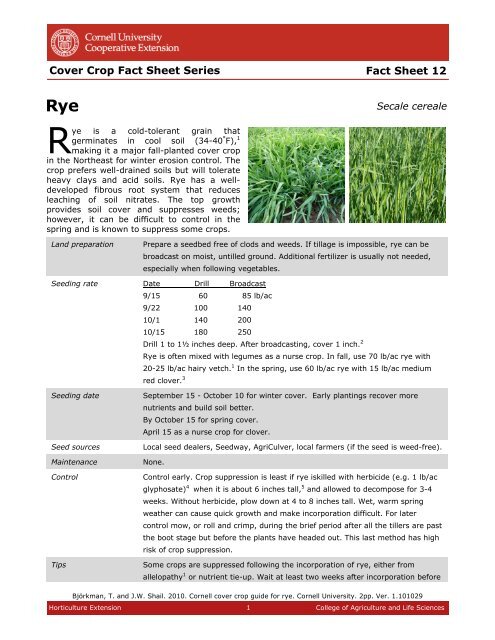Cover Crop Fact Sheet Rye - Horticulture - Cornell University
Cover Crop Fact Sheet Rye - Horticulture - Cornell University
Cover Crop Fact Sheet Rye - Horticulture - Cornell University
Create successful ePaper yourself
Turn your PDF publications into a flip-book with our unique Google optimized e-Paper software.
<strong>Cover</strong> <strong>Crop</strong> <strong>Fact</strong> <strong>Sheet</strong> Series<br />
<strong>Rye</strong><br />
ye is a cold-tolerant grain that<br />
germinates in cool soil (34-40 ° F), 1<br />
R making it a major fall-planted cover crop<br />
in the Northeast for winter erosion control. The<br />
crop prefers well-drained soils but will tolerate<br />
heavy clays and acid soils. <strong>Rye</strong> has a welldeveloped<br />
fibrous root system that reduces<br />
leaching of soil nitrates. The top growth<br />
provides soil cover and suppresses weeds;<br />
however, it can be difficult to control in the<br />
spring and is known to suppress some crops.<br />
<strong>Fact</strong> <strong>Sheet</strong> 12<br />
Secale cereale<br />
Land preparation Prepare a seedbed free of clods and weeds. If tillage is impossible, rye can be<br />
broadcast on moist, untilled ground. Additional fertilizer is usually not needed,<br />
especially when following vegetables.<br />
Seeding rate Date Drill Broadcast<br />
9/15 60 85 lb/ac<br />
9/22 100 140<br />
10/1 140 200<br />
10/15 180 250<br />
Drill 1 to 1½ inches deep. After broadcasting, cover 1 inch. 2<br />
<strong>Rye</strong> is often mixed with legumes as a nurse crop. In fall, use 70 lb/ac rye with<br />
20-25 lb/ac hairy vetch. 1 In the spring, use 60 lb/ac rye with 15 lb/ac medium<br />
red clover. 3<br />
Seeding date September 15 - October 10 for winter cover. Early plantings recover more<br />
nutrients and build soil better.<br />
By October 15 for spring cover.<br />
April 15 as a nurse crop for clover.<br />
Seed sources Local seed dealers, Seedway, AgriCulver, local farmers (if the seed is weed-free).<br />
Maintenance None.<br />
Control Control early. <strong>Crop</strong> suppression is least if rye iskilled with herbicide (e.g. 1 lb/ac<br />
glyphosate) 4 when it is about 6 inches tall, 5 and allowed to decompose for 3-4<br />
weeks. Without herbicide, plow down at 4 to 8 inches tall. Wet, warm spring<br />
weather can cause quick growth and make incorporation difficult. For later<br />
control mow, or roll and crimp, during the brief period after all the tillers are past<br />
the boot stage but before the plants have headed out. This last method has high<br />
risk of crop suppression.<br />
Tips Some crops are suppressed following the incorporation of rye, either from<br />
allelopathy 1 or nutrient tie-up. Wait at least two weeks after incorporation before<br />
planting vegetables. A small amount of legume reduces crop suppression.<br />
Björkman, T. and J.W. Shail. 2010. <strong>Cornell</strong> cover crop guide for rye. <strong>Cornell</strong> <strong>University</strong>. 2pp. Ver. 1.101029<br />
<strong>Horticulture</strong> Extension 1 College of Agriculture and Life Sciences
1<br />
Soil Health Series, Rodale Institute Research Center,<br />
<strong>Fact</strong> <strong>Sheet</strong> # 12, 1993.<br />
2<br />
Clark, A. 2007. Managing <strong>Cover</strong> <strong>Crop</strong>s Profitably,<br />
3rd ed., Sustainable Agriculture Network. p.100.<br />
3<br />
The New Farm’s <strong>Cover</strong> <strong>Crop</strong> Guide, Rodale Research<br />
Center, p.6, 1988.<br />
4<br />
Masiunas, J.B., L.A. Weston, S.C. Weller. 1995. The<br />
impact of rye cover crops on weed populations in a<br />
tomato cropping system, Weed Science 43:318-323<br />
5<br />
Thorup Kristensen, K., D.B. Dresbøll. 2010.<br />
Incorporation time of nitrogen catch crops influences<br />
the N effect for the succeeding crop. Soil Use and<br />
Management 26: 27–35<br />
Disclaimer<br />
This fact sheet reflects the current (and past)<br />
authors’ best effort to interpret a complex body of<br />
scientific research, and to translate this into<br />
practical management options. Following the<br />
guidance provided in this fact sheet does not<br />
assure compliance with any applicable law, rule,<br />
regulation, or standard, or the achievement of<br />
particular discharge levels from agricultural land.<br />
Björkman, T. and J.W. Shail. 2010. <strong>Cornell</strong> cover crop guide for<br />
rye. <strong>Cornell</strong> <strong>University</strong>. 2pp. Ver. 1. 101029<br />
For more information<br />
Field <strong>Crop</strong>s Extension<br />
http://www.nysaes.cornell.edu/hort/buckwheat<br />
Thomas Björkman<br />
Department of Horticultural Sciences<br />
<strong>Horticulture</strong> Extension 2 College of Agriculture and Life Sciences<br />
2010

















